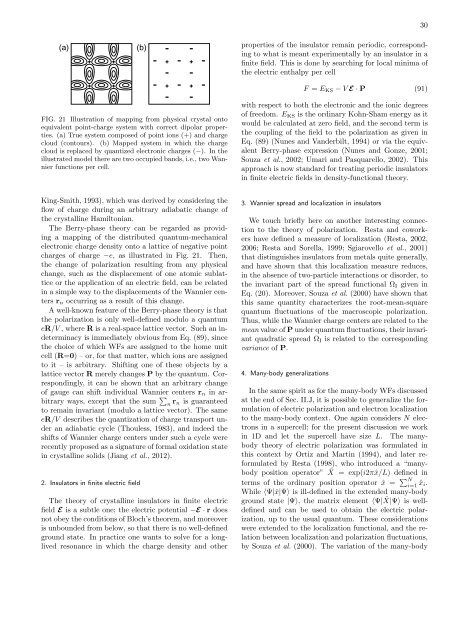Maximally localized Wannier functions: Theory and applications
Maximally localized Wannier functions: Theory and applications
Maximally localized Wannier functions: Theory and applications
You also want an ePaper? Increase the reach of your titles
YUMPU automatically turns print PDFs into web optimized ePapers that Google loves.
(a)<br />
(b)<br />
30<br />
properties of the insulator remain periodic, corresponding<br />
to what is meant experimentally by an insulator in a<br />
finite field. This is done by searching for local minima of<br />
the electric enthalpy per cell<br />
F = E KS − V E · P (91)<br />
FIG. 21 Illustration of mapping from physical crystal onto<br />
equivalent point-charge system with correct dipolar properties.<br />
(a) True system composed of point ions (+) <strong>and</strong> charge<br />
cloud (contours). (b) Mapped system in which the charge<br />
cloud is replaced by quantized electronic charges (−). In the<br />
illustrated model there are two occupied b<strong>and</strong>s, i.e., two <strong>Wannier</strong><br />
<strong>functions</strong> per cell.<br />
with respect to both the electronic <strong>and</strong> the ionic degrees<br />
of freedom. E KS is the ordinary Kohn-Sham energy as it<br />
would be calculated at zero field, <strong>and</strong> the second term is<br />
the coupling of the field to the polarization as given in<br />
Eq. (89) (Nunes <strong>and</strong> V<strong>and</strong>erbilt, 1994) or via the equivalent<br />
Berry-phase expression (Nunes <strong>and</strong> Gonze, 2001;<br />
Souza et al., 2002; Umari <strong>and</strong> Pasquarello, 2002). This<br />
approach is now st<strong>and</strong>ard for treating periodic insulators<br />
in finite electric fields in density-functional theory.<br />
King-Smith, 1993), which was derived by considering the<br />
flow of charge during an arbitrary adiabatic change of<br />
the crystalline Hamiltonian.<br />
The Berry-phase theory can be regarded as providing<br />
a mapping of the distributed quantum-mechanical<br />
electronic charge density onto a lattice of negative point<br />
charges of charge −e, as illustrated in Fig. 21. Then,<br />
the change of polarization resulting from any physical<br />
change, such as the displacement of one atomic sublattice<br />
or the application of an electric field, can be related<br />
in a simple way to the displacements of the <strong>Wannier</strong> centers<br />
r n occurring as a result of this change.<br />
A well-known feature of the Berry-phase theory is that<br />
the polarization is only well-defined modulo a quantum<br />
eR/V , where R is a real-space lattice vector. Such an indeterminacy<br />
is immediately obvious from Eq. (89), since<br />
the choice of which WFs are assigned to the home unit<br />
cell (R=0) – or, for that matter, which ions are assigned<br />
to it – is arbitrary. Shifting one of these objects by a<br />
lattice vector R merely changes P by the quantum. Correspondingly,<br />
it can be shown that an arbitrary change<br />
of gauge can shift individual <strong>Wannier</strong> centers r n in arbitrary<br />
ways, except that the sum ∑ n r n is guaranteed<br />
to remain invariant (modulo a lattice vector). The same<br />
eR/V describes the quantization of charge transport under<br />
an adiabatic cycle (Thouless, 1983), <strong>and</strong> indeed the<br />
shifts of <strong>Wannier</strong> charge centers under such a cycle were<br />
recently proposed as a signature of formal oxidation state<br />
in crystalline solids (Jiang et al., 2012).<br />
2. Insulators in finite electric field<br />
The theory of crystalline insulators in finite electric<br />
field E is a subtle one; the electric potential −E · r does<br />
not obey the conditions of Bloch’s theorem, <strong>and</strong> moreover<br />
is unbounded from below, so that there is no well-defined<br />
ground state. In practice one wants to solve for a longlived<br />
resonance in which the charge density <strong>and</strong> other<br />
3. <strong>Wannier</strong> spread <strong>and</strong> localization in insulators<br />
We touch briefly here on another interesting connection<br />
to the theory of polarization. Resta <strong>and</strong> coworkers<br />
have defined a measure of localization (Resta, 2002,<br />
2006; Resta <strong>and</strong> Sorella, 1999; Sgiarovello et al., 2001)<br />
that distinguishes insulators from metals quite generally,<br />
<strong>and</strong> have shown that this localization measure reduces,<br />
in the absence of two-particle interactions or disorder, to<br />
the invariant part of the spread functional Ω I given in<br />
Eq. (20). Moreover, Souza et al. (2000) have shown that<br />
this same quantity characterizes the root-mean-square<br />
quantum fluctuations of the macroscopic polarization.<br />
Thus, while the <strong>Wannier</strong> charge centers are related to the<br />
mean value of P under quantum fluctuations, their invariant<br />
quadratic spread Ω I is related to the corresponding<br />
variance of P.<br />
4. Many-body generalizations<br />
In the same spirit as for the many-body WFs discussed<br />
at the end of Sec. II.J, it is possible to generalize the formulation<br />
of electric polarization <strong>and</strong> electron localization<br />
to the many-body context. One again considers N electrons<br />
in a supercell; for the present discussion we work<br />
in 1D <strong>and</strong> let the supercell have size L. The manybody<br />
theory of electric polarization was formulated in<br />
this context by Ortiz <strong>and</strong> Martin (1994), <strong>and</strong> later reformulated<br />
by Resta (1998), who introduced a “manybody<br />
position operator” ˆX = exp(i2πˆx/L) defined in<br />
terms of the ordinary position operator ˆx = ∑ N<br />
i=1 ˆx i.<br />
While ⟨Ψ|ˆx|Ψ⟩ is ill-defined in the extended many-body<br />
ground state |Ψ⟩, the matrix element ⟨Ψ| ˆX|Ψ⟩ is welldefined<br />
<strong>and</strong> can be used to obtain the electric polarization,<br />
up to the usual quantum. These considerations<br />
were extended to the localization functional, <strong>and</strong> the relation<br />
between localization <strong>and</strong> polarization fluctuations,<br />
by Souza et al. (2000). The variation of the many-body













